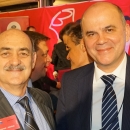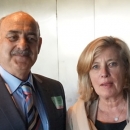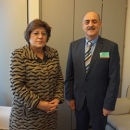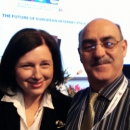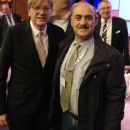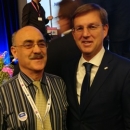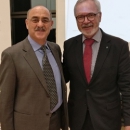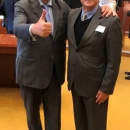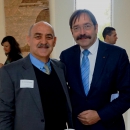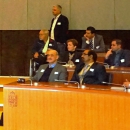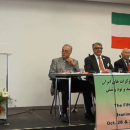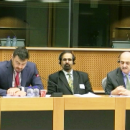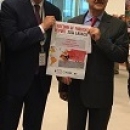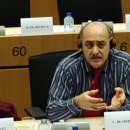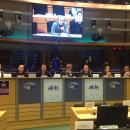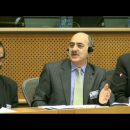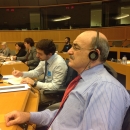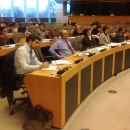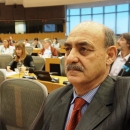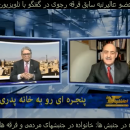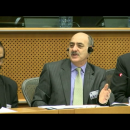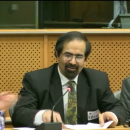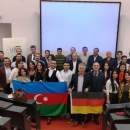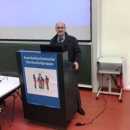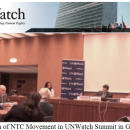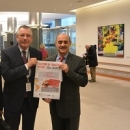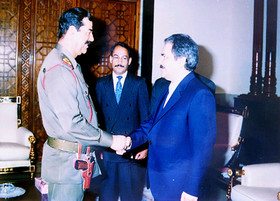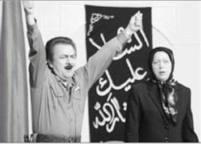Mujahedin-e Khalq Organization (MEK or MKO)
National Liberation Army of Iran (NLA)
People’s Mojahedin of Iran (PMOI)
National Council of Resistance (NCR)
National Council of Resistance of Iran (NCRI)
Muslim Iranian Student’s Society
US Secretary of State John Kerry used a visit to Albania on February 14, 2016 to thank the government for resettling members of the Iranian opposition group Mujahedin e Khalq, or MEK. Over the previous two years, Albania had taken in about 1,000 members of the MEK and had committed to resettling an additional 2,000, said a senior State Department official. Most lived in US-backed camps in Iraq. The US assistance included a donation of $20 million to the UN refugee agency to help resettle the MEK, said the State Department official. The US also provided Albania with security and economic development assistance, to help the country build up its physical capacity to house the refugees.
The United States, which listed National Council of Resistance of Iran as a terrorist organization, closed the NCRI’s Washington office in 2003. The fall of Saddam Hussein’s regime affected the circumstances of the designated foreign terrorist organization Mujahedin-e Khalq (MEK). The MEK was allied with the Iraqi regime and received most of its support from it. The MEK assisted the Hussein regime in suppressing opposition within Iraq, and performed internal security for the Iraqi regime. The National Liberation Army was the military wing of the National Council of Resistance of Iran.
The Mujahideen-e Khalq (MEK also known as PMOI, MKO, NCRI, Muslim Iranian Students, Society, Organization of the People,s Holy Warriors of Iran, the National Liberation Army, Sazeman-e Mujahideen-e Khalq Iran) has used a number of names, or front organizations.
The MEK has a history that does go back to the time of the Shah in the 1970s. It was a group that propounded an ideology that mixed Islamism and Marxism. And, among their earliest operations were lethal operations against US personnel, including US military personnel, in Iran. In the 1979 Islamic Revolution, the MEK backed Ayatollah Khomeini and the seizure of the U.S. Embassy in Tehran. By 1981, however, the MEK split with the cleric-based regime, launching a bombing campaign that killed Iran’s president and prime minister. Then, its leadership fled to Europe.
The MEK sided with Iraq in its 1980-1988 war with Iran. In 1986, Iraqi dictator Saddam Hussein set up an enclave called Camp Ashraf for the group north of Baghdad. In 1991, MEK forces allegedly assisted Saddam in putting down uprisings by the Kurds in Iraq’s north, and the Shi’ites in the south. Then, in April 1992, the MEK attacked Iranian embassies and facilities in 13 countries. In 1997, a new U.S. law put the MEK and 29 other groups on the Foreign Terrorist Organization list. Britain and the European Union also put the MEK on terrorist lists.
Then, in 2002, the group said it had uncovered Iranian nuclear facilities at Natanz and elsewhere. The next year, U.S. and coalition forces toppled Saddam Hussein.
By 2004 Mujahedin-e-Khalq [MEK] facilities in Iraq included
- Camp Ashraf, the MEK military headquarters, is about 100 kilometers west of the Iranian border and 100 kilometers north of Baghdad near Khalis
- Camp Anzali near the town of Jalawla [Jalula] (120-130 km (70-80 miles) northeast of Baghdad and about 40-60 km (20-35 miles) from the border with Iran)
- Camp Faezeh in Kut
- Camp Habib in Basra
- Camp Homayoun in Al-Amarah
- Camp Bonyad Alavi near the city of Miqdadiyah in Mansourieh [about 65 miles northeast of Baghdad]
On 10 May 2003 V Corps accepted the voluntary consolidation of the Mujahedin-E-Khalq’s forces, and subsequent control over those forces. This process is expected to take several days to complete. Previously, V Corps was monitoring a cease-fire brokered between the MEK and Special Forces elements. The MEK forces had been abiding by the terms of this agreement and are cooperating with Coalition soldiers.
By mid-May 2003 Coalition forces had consolidated 2,139 tanks, armored personnel carriers, artillery pieces, air defense artillery pieces and miscellaneous vehicles formerly in the possession of the Mujahedin-E Khalq (MEK) forces. The 4th Infantry Division also reported they have destroyed most of the MEK munitions and caches. The voluntary, peaceful resolution of this process by the MEK and the Coalition significantly contributed to the Coalition’s mission to establish a safe and secure environment for the people of Iraq.
The 4,000 MEK members in the Camp Ashraf former Mujahedeen base were consolidated, detained, disarmed and were screened for any past terrorist acts. These residents opposed the clerical regime in Tehran and, as a result of that opposition, lived in constant danger of attack from pro-Iranian forces.
In 2004, the United States recognized the residents as “protected persons” under the Fourth Geneva Convention and pledged to protect the residents until their final disposition. The United States turned over control and responsibility of the residents to the Government of Iraq in early 2009, as reflected in the United States Embassy Statement on Transfer of Security Responsibility for Camp Ashraf of December 28, 2008.
In July 2008, the Mujahideen-e Khalq (MEK) petitioned the Department for a revocation of its designation as a Foreign Terrorist Organization (FTO). A petitioning organization must provide evidence that the relevant circumstances are sufficiently different from the circumstances that were the basis for the designation such that a revocation with respect to the organization is warranted. The Secretary determined on January 7, 2009 that the FTO designation of the MEK will be maintained. The Secretary found that the MEK remained a foreign organization that retained the capability and intent to engage in terrorist activity or terrorism. The Secretary’s determination to maintain the MEK’s FTO designation did not alter the status under U.S. law of the individuals at Camp Ashraf.
The 3,400 residents of Camp Ashraf lived communally (males and females separately), supported by light manufacturing and donations from abroad. They claimed to have turned over all their arms to US forces in 2003, and their camp 60 miles from Baghdad looks more like a relatively affluent Iraqi village than a military garrison. However, until the end of 2008, residents wore military-style uniforms and flew pre-revolution Iranian flags, and U.S. forces stationed at Forward Operating Base (FOB) Grizzly on the periphery of the camp report that they continue to practice small unit military tactics and maneuvers under cover of darkness.
Camp residents provided Iraqi Army units now guarding the camp with meals, provided a trailer for the Iraqi commanding officer, provided a meeting room for the GoI committee, and installed space heaters in guard towers for the Iraqi troops. They also continued to build goodwill with surrounding Iraqi villages by providing employment in the camp.
These residents moved from the former Camp Ashraf to Camp Liberty/Hurriya, which is adjacent to the Baghdad International Airport, following a December 2011 Memorandum of Understanding reached between the United Nations and the Government of Iraq, and brokered by the Government of the United States, for the express purpose of resettling them as refugees to third countries. The residents left behind valuable personal property and assets at Camp Ashraf, under the explicit agreement that they would retain title to such property and assets.
It was reported on 21 September 2012, that the US State Department was preparing to remove the Mujahedin-e Khalq Organization from the list of organizations recognized as terrorist groups by the United States. On 28 September 2012, the US State Department formally announced that it had delisted the organization as a Specially Designated Global Terrorist under Executive Order 13224. The decision took into account the MEK’s public renunciation of violence, the absence of confirmed acts of terrorism by the MEK for more than a decade, and their cooperation in the peaceful closure of Camp Ashraf, their historic paramilitary base. On September 28, 2012 the Secretary of State decided, consistent with the law, to revoke the designation of the Mujahedin-e Khalq (MEK) and its aliases as a Foreign Terrorist Organization (FTO) under the Immigration and Nationality Act and to delist the MEK as a Specially Designated Global Terrorist under Executive Order 13224. Property and interests in property in the United States or within the possession or control of U.S. persons will no longer be blocked, and U.S. entities may engage in transactions with the MEK without obtaining a license.
The United States consistently maintained a humanitarian interest in seeking the safe, secure, and humane resolution of the situation at Camp Ashraf, as well as in supporting the United Nations-led efforts to relocate eligible former Ashraf residents outside of Iraq.
By the end of 2013 the UN reported a population of 1,957 persons in Camp Hurriya. Authorities relocated 1,119 residents of Camp Hurriya to foreign countries, either independently (63 individuals) or through the UNHCR relocation program (1,056 individuals). The majority of relocations were to Albania.
According to AI, a Shia militia, the al-Mukhtar Army, claimed responsibility for an 29 October 2013 rocket attack on Camp Hurriya that killed at least 24 residents. Government authorities responded to the attack by providing emergency services and doctors to the camp. On September 21, a militia group also attacked residents of the camp and killed three Iraqi security personnel. There continued to be no information on the whereabouts of seven Mujahedin-e-Khalq members abducted from Camp Ashraf in 2013.
Many members of the Mujahedin-e Khalq were still interned at Camp Ashraf and Camp Liberty in Iraq as they awaited countries to take them as refugees. By 2014 the UN had appointed a special representative to seek relocation opportunities for this group.
The residents have come under attack several times since their relocation to Camp Liberty/Hurriya. Iraqi forces who bear responsibility for guarding the camp have failed to protect its residents from repeated attacks. The number of dead passed 20 as a result of the extensive missile attack on Camp Liberty in Iraq on 29 October 2015 against the Iranian dissidents where 2,400 members of the MEK resided. Some of the missiles used were Falaq missiles produced by the Iranian regime. As many as 80 missiles were fired at Camp Liberty and holes as deep as 7 feet and as wide as 12 feet are created. Over 140 residents have died as a result of the attacks, 7 have been abducted, and more than 1,300 wounded by early 2016.
Groups affiliated with the Iranian regime’s Revolutionary Guard Qods Force have claimed responsibility for attacks and warned that more would follow if the residents did not leave Iraq. Iraqi security forces are permanently stationed around Camp Liberty/Hurriya, despite their past violence against the unarmed residents. The security of Camp Liberty/Hurriya is clearly inadequate to protect the residents from armed assault and rocket attack.
By 2016 approximately 2,000 unarmed members of the Iranian opposition movement, the Mujahedin-e Khalq (MEK) resided in Camp Liberty/Hurriya awaiting resettlement by the United Nations High Commissioner for Refugees (UNHCR), which has recognized them as “persons of concern” and “in need of international protection”.
Description
Mujahedeen-e-Khalq (MEK) is the largest and most militant group opposed to the Islamic Republic of Iran. Also known as the People’s Mujahedeen Organization of Iran, MEK is led by husband and wife Massoud and Maryam Rajavi. MEK was added to the U.S. State Department’s list of foreign terrorist groups in 1997.
MEK was founded in the 1960s by a group of college-educated Iranian leftists opposed to the country’s pro-Western ruler, Shah Mohammad Reza Pahlavi. Although the group took part in the 1979 Islamic revolution that replaced the shah with a Shiite Islamist regime, MEK’s ideology, a blend of Marxism and Islamism, put it at odds with the postrevolutionary government. In 1981, the group was driven from its bases on the Iran-Iraq border and resettled in Paris, where it began supporting Iraq in its eight-year war against Khomeini’s Iran. In 1986, MEK moved its headquarters to Iraq where it received its primary support to attack the regime in Iran. During the 2003 Iraq war, U.S. forces cracked down on MEK’s bases in Iraq, and in June 2003 French authorities raided an MEK compound outside Paris and arrested 160 people, including Maryam Rajavi.
Activities
The group targeted Iranian government officials and government facilities in Iran and abroad; during the 1970s, it attacked Americans in Iran. MEK’s past acts of terrorism included its involvement in the killing of U.S. citizens in Iran in the 1970s and an attack on U.S. soil in 1992. While the group says it does not intentionally target civilians, it has often risked civilian casualties. It routinely aims its attacks at government buildings in crowded cities. MEK terrorism has declined since late 2001. Incidents linked to the group include:
- The series of mortar attacks and hit-and-run raids during 2000 and 2001 against Iranian government buildings; one of these killed Iran’s chief of staff
- The 2000 mortar attack on President Mohammad Khatami’s palace in Tehran
- The February 2000 “Operation Great Bahman,” during which MEK launched 12 attacks against Iran
- The 1999 assassination of the deputy chief of Iran’s armed forces general staff, Ali Sayyad Shirazi
- The 1998 assassination of the director of Iran’s prison system, Asadollah Lajevardi
- The 1992 near-simultaneous attacks on Iranian embassies and institutions in 13 countries Assistance to Saddam Hussein’s suppression of the 1991 Iraqi Shiite and Kurdish uprisings
- The 1981 bombing of the offices of the Islamic Republic Party and of Premier Mohammad-Javad Bahonar, which killed some 70 high-ranking Iranian officials, including President Mohammad-Ali Rajaei and Bahonar Support for the 1979 takeover of the U.S. Embassy in Tehran by Iranian revolutionaries
- The 1970s killings of U.S. military personnel and civilians working on defense projects in Tehran
In the early 1970s, angered by US support for the pro-Western shah, MEK members killed several US soldiers and civilians working on defense projects in Iran. Some experts said the attack may have been the work of a Maoist splinter faction operating beyond the Rajavi leadership’s control. MEK members also supported the 1979 takeover of the US Embassy in Tehran, in which 52 Americans were held hostage for 444 days.
Strength
MEK was believed to have several thousand members, one-third to one-half of whom are fighters. MEK activities have dropped off in recent years as its membership has dwindled.
Location/Area of Operation
The group’s armed unit operated from camps in Iraq near the Iran border since 1986. During the Iraq war, US troops disarmed MEK and posted guards at its bases. In addition to its Paris-based members, MEK has a network of sympathizers in Europe, the United States, and Canada. The group’s political arm, the National Council of Resistance of Iran, maintains offices in several capitals, including Washington, DC.
External Aid
When Saddam Hussein was in power, MEK received the majority of its financial support from the Iraqi regime. It also used front organizations, such as the Muslim Iranian Student’s Society, to collect money from expatriate Iranians and others, according to the State Department’s counterterrorism office. Iraq was MEK’s primary benefactor. Iraq provided MEK with bases, weapons, and protection, and MEK harassed Saddam’s Iranian foes. MEK’s attacks on Iran traditionally intensified when relations between Iran and Iraq grew strained. Iraq encouraged or restrained MEK, depending on Baghdad’s interests.
Leadership
Maryam Rajavi is MEK’s principal leader; her husband, Massoud Rajavi, head up the group’s military forces. Maryam Rajavi, born in 1953 to an upper-middleclass Iranian family, joined MEK as a student in Tehran in the early 1970s. After relocating with the group to Paris in 1981, she was elected its joint leader and later became deputy commander-in-chief of its armed wing.
Massoud Rajavi was last known to be living in Iraq, but authorities aren’t certain of his whereabouts or whether he is alive. The last time Rajavi was heard of was in 2003 when he issued a statement on Ashura Day. After the US invasion of Iraq in 2003 and the coincident disappearance of Massoud Rajavi, many criticized him for leaving his members in danger and escaping to save his own life. In 2009 MEK members exchanged text messages with someone claiming to be MEK leader Massoud Rajavi, who had not been seen since the Coalition Forces (CF) invasion of Iraq in 2003. Some said he was detained in a cell adjacent to that of late Iraqi President Saddam Hussein while others said he is under house arrest in Iraq. There were also reports that he was at the U.S. Naval Forces 5th fleet in Bahrain and that he was seen at the U.S. Army headquarters in Qatar. He was also rumored several times to have been arrested by Jordanian security. Unconfirmed news from several sources in Tehran reported 26 August 2010 the death of Massoud Rajavi. The news of the death of Massoud Rajavi was first posted on the website of reformist leader Dr. Mehdi Khazali.
In an 07 October 2015 hearing before the US Senate committee on Armed Forces titled” Iranian Influence in Iraq and the case of Camp Liberty”, prominent MKO lobbyist, retired Colonel Wesley Martin pretended to be informed about the proper answer. He claimed that Rajavi was wounded in an attack and he was in France.

